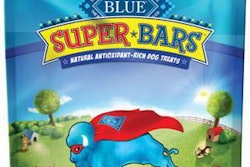
Once only obtained through a quest to a pet specialty retailer, premium dog and cat food brands now line pet aisle shelves in grocery stores. Premium and superpremium pet food sales continue to grow in the U.S. food, drugs and mass market (FDM) retail channel.
While pet specialty stores still account for 24% of U.S. pet product sales, FDM retailers now make up approximately 40% of U.S. pet product sales, according to Packaged Facts’ U.S. Pet Market Outlook, 2019-2020. Twenty percent of those FDM sales occur in discount stores and supercenters, including Walmart; 12% of sales are now in grocery or food stores; and another 8% are in wholesale club stores.
Premium natural and specialty pet food and treat brands increased U.S. FDM retail sales by 23% year-over-year in 2019, compared to 6% for the category overall, said Amy Kerr, pet sector client development director for market analysis firm SPINS.
Blue Buffalo’s entry into Target, Kroger, Publix and Meijer in August 2017 may have made the largest waves, but numerous other premium brands have moved into grocery stores and similar shops. Meanwhile, FDM retailers have increased their own premium private label offerings. That mass premiumizaton of pet food had upshots for many brands, including American Nutrition. The Utah, USA-based company has grown sales of both their own premium brands and those they produce for others.
“American Nutrition has definitely had more customers requesting premium formulas in the past decade,” Steve Mills, senior vice president of customer brand and co-manufacturing sales for American Nutrition, said. “Customer focus has moved from mainstream formulas to premium and superpremium. The growth of big-box pet specialty and independent retailers, and the move to FDM by many brands that in the past were only available at pet specialty retailers, have spurred this transition. We’ve seen this happening for a while, but big brands moving from pet specialty retail to FDM really accelerated things.”
Blue Buffalo leveraged General Mills’ FDM experience
Less than a year after Blue Buffalo began selling its BLUE Life Protection Formula though FDM channels, General Mills acquired the company in February 2018 for approximately US$8 billion. That purchase immediately made General Mills the sixth-largest pet food company worldwide, according to Petfood Industry’s Top Companies current data. General Mills was already a rather large gorilla in the theater of FDM retail with brands like Gold Medal flour (since 1880), Betty Crocker and Cheerios. This allowed General Mills to follow successful models in expanding Blue Buffalo’s presence on the pet food aisle. Blue Buffalo’s Wilderness line launched in FDM stores in 2019.
“As Blue entered the food, drug and mass channel, we were able to leverage General Mills’ strong relationships and broad capabilities to drive revenue growth opportunities and greater efficiencies,” Kelsey Roemhildt, General Mills’ corporate communications manager, said. “We have a strong track record of integrating acquisitions and accelerating growth among natural and organic brands – as an example, the success we’ve had with Annie’s demonstrates that we can do this right …
“Similar to human food, innovation is key in pet and we continue to innovate to make sure that we have the right products with the right sizes in all the right channels,” she said.
General Mills’ pet food and treat sales increased 16% in the second quarter of fiscal year 2020 and reached US$389 million in net sales. E-commerce sales contributed to this growth, along with FDM sales.
“Importantly, retail sales for FDM customers who have carried BLUE more than 12 months were up 45% in Q2,” Roemhildt said.
However, as Blue Buffalo succeeded in the mass market, it may have ceded ground in pet specialty shops as retail sales in that sector declined. Pet specialty channels now provide locations for exclusive programs and innovations for Blue Buffalo, she said.
“Specialty pet retailers continue to play an important role in the shift by educated pet parents as they purchase ‘healthier’ products for their pets,” Kerr said. “While pet food with a focus on health continues to grow and brands are expanding their footprint to conventional retail, specialty retailers will continue to be a trusted partner among pet owners looking to introduce the latest advancement in pet nutrition into their lives. One example is pet specialty retailers are increasing their freezer and refrigerated space to continue to differentiate from FDM and grocery. SPINS is tracking a 15% growth in dollars in products with raw as an attribute.”
FreshPet refrigerated pet foods in mass market retailers
One refrigerated pet food company moved into the mass market and held onto pet specialty retail sales, despite logistical challenges.
“For the most part, we see different consumers with different needs shopping within these channels,” Jake Trainor, head of marketing at Freshpet, said. “So, we strive to have the right products and assortment available that meet their needs.”
Those needs include fresh, minimally processed, healthy foods for both humans and their dogs and cats, he said. Growing health consciousness among consumers benefited Freshpet, as the company’s business has nearly doubled since 2016 from US$173 million in sales to US$328 million (52 weeks preceding Feb. 1, 2020).”
Freshpet’s household penetration sits below 2%, Trainor said, leaving significant headroom to grow the refrigerated pet food company’s consumer base and overall business. Being a refrigerated pet food creates some challenges for FreshPet as it continues to expand in FDM stores, but they are obstacles the company has faced since its inception.
“When the business was started nearly 15 years ago there were challenges both selling the unique proposition of fresh pet food and finding space in a retailers’ pet aisle,” Trainor said. “At the start, our team customized fridge sizes to meet the space available at retailers. However, as time has gone on, retailers saw how Freshpet grew their pet category by bringing in new consumers and driving continued foot traffic with our high purchase frequency.”
Now those retailers ask how they can do more.
“We’ve had a number of large retailers over the past couple years add a second four-foot refrigerator and in some cases three of those refrigerators to their stores to expand its Freshpet assortment,” he said. “The addition of larger refrigerators and multiple refrigerators will continue to expand in 2020 with even more retailers.”
Differences between producing premium and conventional pet foods
Just as retailers make changes to accommodate Freshpet, pet food manufacturers adapt to the demands of producing premium pet food. Premium and superpremium formulas contain higher-quality meals instead of by-product meals, along with additional meat slurries, novel proteins, superfoods, higher potency vitamins and minerals, and much more, Mills of American Nutrition said.
“These formulas are more expensive than mainstream formulas because the ingredients are much more costly and the cost to produce them is higher,” he said. “Many times the packaging is also upgraded, driving up the cost difference.”
Producing private label pet food is no more difficult or time consuming than the company's non-private label business, Mills said.
“The changes in FDM actually simplify our process because we can inventory fewer ingredients,” he said. “However, most brands and private label formulas are looking for differentiation, which means more exotic ingredients and protein sources, which can be difficult to source. It’s likely to be a never-ending quest.”
While pet food companies continue their search for differentiation, pet owners may make fewer odysseys of their own, since buying premium pet foods no longer requires patronizing a pet specialty shop.
“Customer focus has moved from mainstream formulas to premium and super premium.”

















